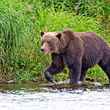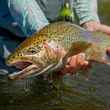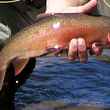Winter draws to an early close in the South. I noticed the first spring beauty, an exquisite and appropriately named wildflower, in my yard on January 26 this year. Male spring peepers and cricket frogs feel the pull of hormones and start singing for the ladies around mid-February. But along about the time redbuds are blushing, I start listening for the return of another old springtime friend. This friend is also a singer. His melancholy serenade is the essence of a spring night. He sounds lonesome, and that may be part of the reason he was named Chuck-will’s-widow.
Many of you may know the Chuck as a whip-poor-will. I’ve lumped him with his cousin in a generic name, too, just like we when I was a kid and we called all soft drinks a “coke.” But while similar, they are two separate species. The physical appearances are nearly identical; it’s their songs that are the giveaway.
The Chuck has a distinctly slower cadence, a soulful drawling rhythm in his mournful song, while the whip-poor-will has a snappier tempo and more staccato notes. The best analogy would be the Chuck sings a waltz and the whip-poor-will a polka. When I was a boy, Dad told me that the birds were singing “chip-butter-in-the-white-oaks.” I had no idea what chip butter is or why it would be in the white oaks. Still don’t. Dad didn’t have an explanation either, but I must admit that the rhythm of a Chuck’s call, like so many other bird calls, makes it a flexible vehicle for regional interpretations. Chip-butter-in-the-white-oaks may not make sense to you. But then, “Chuck-will’s-widow” or “whip-poor-will” or “Bob-White” or “towhee” or “kill-deer” don’t make a hell of a lot of sense as bird vocalizations either.
Chucks are very vocal. I don’t know at what decibel level they sing, but it is loud. What is an enchanting forest melody at 100 yards turns into a near-deafening demon scream for female attention when it’s just outside the bedroom window.
Chucks think that it’s better to be seen than to be heard, and getting a visual on them is a problem. On the ground, they blend in perfectly with the leaf litter. I’ve no doubt walked past scads of them. Their cryptic camouflage is a hint toward their habits. Chucks are ground-nesting birds. They stake their lives and the lives of future Chuck generations on the ability to disappear in plain sight. But if you can spot them it’s fairly easy to get close and they don’t seem particularly concerned with your presence. They trust their camouflage and instinctively know it’s best not to move unless they absolutely must. I remember my first visual encounter with a Chuck as a boy on a lazy late-spring twilight and my unsuccessful attempt to capture it. I could get almost within striking distance and then it would take wing only to land a few yards away. I would start another stalk and it would end with the same results, and this went on until total darkness finally made it impossible to see the Chuck. Only then did I realize how deep into the woods I'd gone.

Chucks have small feet that aren’t designed for perching, though, you will occasionally see them on a branch. I’ve never seen them actually walk, but I have witnessed them scoot around on the ground. The bird also has a small beak, which is in total contradiction to its enormous mouth. The mouth is what gave the nightjar family of birds, to which the Chuck belongs, its nickname of “goatsucker.” In the old days, folks thought the huge mouth enabled the birds to feed on goat’s milk directly from the goat’s udder. We now know differently of course. The Chuck uses that big mouth to scoop insects and the occasional small bird or bat on the wing as it sweeps over pastures and through the forest understory. They have a wispy flight as they flitter through the woodlands. It’s quite a contrast to the strong wing beats of their cousins, the nighthawks, that spend more time in open air above the forest canopy.
The biology and physiology of the bird is interesting, but the mystique is what makes the Chuck one of my favorites. Hearing them on a cool spring sundown or as I wait for sunrise on an Ozark ridge always brings a smile. I can’t count the nights that the lonesome call of “Chuck-will’s-widow” or “chip-butter-in-the-white-oaks,” if you will, sang me to sleep. When I hear them now, I’m transported back to a simpler time. The years melt away and I’m a boy, peering through the screened window at my grandparent’s house. A silver moon peeks over the hill, and the woodland lullaby gives seasoning to a peaceful country evening.































Comments